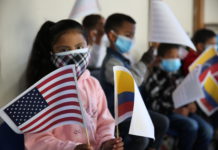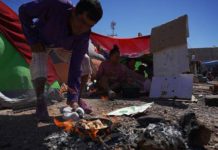
Immigration and Refugee Board of Canada
www.irb-cisr.gc.ca
Frequently Asked Questions (FAQS)
Bill C-31 – Protecting Canada’s Immigration System Act
Bill C-31
Q1. What changes are being proposed?
Several amendments to legislation are being proposed that the government believes would further improve the refugee determination system including:
- Reducing the timelines at the Immigration and Refugee Board of Canada (IRB) for refugee hearings and refugee appeals.
- Changing how countries of origin would be designated.
- Eliminating the information-gathering interview and replacing it with the requirement to complete a Basis of Claim (BOC) form.
- Barring access to the RAD for claimants from Designated Countries of Origin (DCOs); those who have manifestly unfounded claims or claims with no credible basis; those who were exempted from the Safe Third Country Agreement; and those who applied before the coming into force of the new system (i.e. those in the backlog).
- Implementing a 1-year bar for Humanitarian and Compassionate (H&C) Consideration for failed refugee claimants, as well as a bar on concurrent H&C applications for those who submitted a claim for refugee protection.
- Implementing a 1-year bar on subsequent applications for a pre-removal risk assessment (PRRA), following a decision on the first application.
- Transferring of the PRRA functions to the IRB two years following the Coming into Force date of the legislation.
- Providing for a concurrent loss of permanent resident status when the IRB finds a person has ceased to be a protected person or Convention refugee.
- Allowing for the creation of regulations to clarify the factors that may or may not be considered by the CBSA in deferring a removal.
- Preventing the IRB’s ability to re-open claims decided at a higher level.
- Expanding and facilitating Ministers’ ability to intervene in proceedings at the RAD.
- Denying work permits and associated benefits for claimants from DCO countries unless their claim is accepted at the IRB or their refugee claim has been in the system for more than 180 days with no decision.
- Changing the eligibility criteria for those with serious criminality and only allowing access to a pre-removal risk assessment which would not lead to permanent resident status.
*See also the CIC website for further information on the changes.
Q2. What is the difference between a designated country of origin and a safe third country?
According to the proposed legislation, designated countries of origin would include countries that do not normally produce refugees, have a robust human rights record and offer state protection. States with democratic, judicial and accountability frameworks are considered likely to provide the necessary protection to their citizens. Claimants from designated countries of origin would have access to a fair hearing of their refugee claim by an IRB decision maker. If their claim fails, they would be subject to expedited removal from Canada .
A safe third country is one with a refugee system that meets a similar standard to Canada’s, and with which Canada has signed an agreement to share responsibility for refugee claim determination.
Canada’s only Safe Third Country Agreement is with the United States . The agreement applies to refugee claimants who are seeking entry to Canada from the U.S. or vice versa at Canada-U.S. land border crossings. Under this Agreement, unless they qualify for an exception, refugee claimants must seek protection in whichever country they first have the opportunity to do so. This agreement does not apply to Canadian or U.S. nationals.
Q3. How will the Basis of Claim (BOC) document differ from the Personal Information Form (PIF) currently being used?
The Basis of Claim (BOC) document, including its content, will be described in the RPD Rules. The IRB will consult internally and externally on the content of the BOC document as part of the Rules consultation process. It is likely to be a much shorter document than the PIF and focussed on specific aspects of the claim for protection. Furthermore, the so-called “tombstone data” will be collected in the IMM 008 and thus, will not need to be duplicated in the new BOC. The extensive work already completed in the context of the information-gathering interview will assist in the development of the BOC form.
Q4. When do you expect the new legislation to be implemented? How will this impact the June 29, 2012 Coming into Force (CIF) date of Bill C-11?
The Balanced Refugee Reform Act was originally intended to come into force by June 29, 2012. However, in order to ensure the orderly implementation of a comprehensive, reformed refugee system, the proposed legislation would amend the Coming into Force (CIF) date to allow for a date to be set by the Governor in Council. The government has, to date, not announced any change to the Coming Into Force date of June 29, 2012.
Q5. What is the difference between Royal Assent and Coming into Force?
Once Royal Assent is given to a bill, it becomes law and comes into force either on that date or at a date provided for within the Act or specified by an order of the Governor in Council. Until the new law is actually in force, we continue to operate under the current law. Without Coming into Force (CIF), the law does not come into effect.
Q6. What if the Bill changes in committee?
Although the government has a majority in both the House of Commons and Senate, the Bill may change in committee. We will closely monitor the Bill’s progress through the parliamentary process and adjust as required, as we did with the BRRA as it worked its way through Parliament.
Q7. What will happen to CIC’s draft regulations and the IRB Rules that were pre-published in 2011 (e.g., regulations regarding processing timelines, designated countries of origin and pre-removal risk assessments)?
Those draft Regulations and IRB Rules were never finalized. Once the new Act is finalized, the government would proceed with amended Regulations and the IRB with amended Rules, as necessary.
Staffing
Q8. When will new RPD members be hired?
New Member RPD decision maker pools resulting from the first process are expected to be completed by March 2012 and the majority of the RPD members will be hired about two months before Coming into Force to allow for training.
Q9. When will current staffing processes be completed?
RPD analysts and adjudicative support positions that may be created in the other divisions will be staffed as part of a staffing strategy that has not yet been determined. These positions need to be developed and classified before the staffing process can begin. These should be staffed by Coming into Force. Information on these and any other staffing processes that may arise will be shared when it becomes available.
Impacts on IRB’s Mandate and Operations
Q10. How can the IRB render fair decisions within these new timelines?
In order to meet the new timelines, RPD members will have to have greater ownership of their assigned refugee claim files and will be required to review them within a few days of referral. The new legislation and anticipated regulations continue to provide a right to a hearing for all claimants, and recognize that hearings may be postponed or adjourned where natural justice or fairness requires it.
During consultations on the Regulations last year, many stakeholders expressed a preference to maintain the Personal Information Form (PIF) instead of implementing an information-gathering interview. The new Basis of Claim (BOC) form will help guide claimants as they build their cases.
Q11. Won’t Front End Security Screening (FESS) delay the hearing of refugee claims?
Funding has been given to our partner agencies and they have committed to completing the majority of security screenings within prescribed timeframes. The new RPD does anticipate some delays in receiving FESS results for some claims and we are working on strategies to mitigate this issue.
Q12. How will the Refugee Appeal Division (RAD) address the changes proposed in Bill C-31?
A number of claimants will no longer have the opportunity to appeal to the Refugee Appeal Division, notably:
- claimants from Designated Countries of Origin (DCOs);
- those who have manifestly unfounded claims or claims with no credible basis;
- those who were exempted from the Safe Third Country Agreement;
- and those who applied before the coming into force of the new system (i.e. those in the backlog).
The above-noted list will continue to be able to make an appeal to the Federal Court of Canada.
The RAD will be predominantly a written appeal. An appeal case will be assigned to a RAD Member, once the required documents have been received from the parties. The RAD member will review the information submitted by the parties prior to rendering a written decision. Pilot studies of how a focussed RAD oral hearing will proceed are ongoing and the question of how the file will be managed will not be fully known until after these pilots are concluded and analyzed.
Q13. How does the Minister’s role change at the RAD?
The draft legislation provides greater powers and flexibility to the Minister to intervene at the RAD. The Minister would be able to intervene at a RAD proceeding at any time before a decision is rendered, without having to comply with the requirements to file and perfect an appeal. If he chooses to be a party, he would need to meet the timelines for filing but need not meet the “perfection” requirements.
Immigration Appeal Division and Immigration Division
Q14. What do the legislative changes mean for the ID and IAD?
The changes resulting from the new legislation clarify when certain ID proceedings are to be conducted in the absence of the public. However, these changes do not impact the structures and processes of the ID and the IAD – except, perhaps in Toronto.
Elimination of the Tribunal Officer (TO) role in the RPD will mean that the ID and IAD, as well as the RAD, will have to determine the specific needs and develop adjudicative support positions that will meet those needs.
PRE-Removal Risk Assessment (PRRA)
Q15. Why has the transfer of the Pre-Removal Risk Assessment (PRAA) been delayed by a year?
Citizenship and Immigration Canada (CIC) has opted to delay the transfer of the PRRA to give CIC more time to reduce the exiting PRRA backlog. Any PRRA backlog that remains on the date two years after Coming into Force will be transferred to the IRB.
Registry
Q16. What will the organizational structure of the registry be?
The RPD will be supported by an RPD registry that reports directly within the division. Registry staff will be organized in adjudicative teams working very closely with the members that they support.
The IAD and ID registries (as well as the RAD registry when it is created) will report to the regional operations management structure, much as they do now.
The ID registry in Central Region, located at Queen’s Plate, will report to the ADC of the ID in Central Region. This is informally the case presently, but it will be formalized with the new law.
More details on this organizational structure have not yet been determined.
We do anticipate that some registry functions that are common to all divisions, such as Records and Mail, and interpreter scheduling, will not become part of a division as these services are more efficiently provided by the region as a whole instead of by each division.
Implementing the Changes
Q17. When will these changes take effect?
We will continue to prepare for the changes as the Bill works its way through Parliament to Royal Assent. After Royal Assent, we will continue to prepare for the changes in order to be ready to implement the new system at Coming into Force (CIF).
Q18. Can the IRB actually implement this much change in a short period of time?
We are confident this can be done. Much reform-related work, including preparing for and dealing with issues in relation to major change, has already been accomplished and it is still relevant. The new RPD and RAD have already begun to map and detail their processes under this new legislation. The Reform Office is in the process of updating the project plan and deadlines and is meeting with all project leads to discuss any required changes to their respective work plans. RAD process mapping has also begun.
IRB Rules
Q19. Will the IRB need to rewrite its Rules?
Yes, some of our Rules will have to be re-written as a result of the proposed changes to the Act. Legal Services is working under very tight timeframes and has already begun this task. The IRB will consult on the new Rules.
Q20. What will be the process to consult?
As in the past, we intend to consult with staff and key stakeholders. There will be formal consultation with all Canadians during the normal regulatory approval processes.
Backlog
Q21. Why does the bill provide for Government In Council Refugee Protection Division (RPD) Members to be able to hear RPD backlog claims after Coming into Force and why will Public Servant RPD members be hired and allowed to decide refugee cases between Royal Assent and Coming into Force of the new Act?
This provision was included in the legislation to provide the IRB with the flexibility to manage its backlog.
At Coming into Force, it is possible that we may have more Governor in Council (GIC)1 Members in mandate than are required for the Refugee Appeal Division. If this is the case, these Members would be able to continue to hear refugee claims made before Coming into Force until their mandates and any post-mandate periods expire. As claims made before Coming into Force will not be eligible for to appeal to the Refugee Appeal Division, there would be no conflict should these Government In Council members be appointed to the Refugee Appeal Division at a future time. This allows the Board to benefit from the experience of these current RPD Members in reducing the backlog.
Likewise, providing for the Board to bring on new Public Service RPD members before Coming into Force, provides another opportunity to appoint new RPD members earlier and begin to train them for the new system, by giving them refugee decision making experience. This will allow those Public Servant RPD Members to gain experience in hearing and rendering refugee decisions prior to Coming into Force. This will help the IRB further reduce the backlog before Coming into Force.
_____________________________
1. A Governor in Council (GiC) appointment is one made by the Governor General, on the advice of the Queen’s Privy Council of Canada (i.e., the Cabinet). The appointments are made through an Order in Council (OIC) and range from heads of agencies and chief executive officers of Crown corporations to members of quasi-judicial tribunals.











